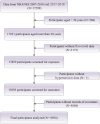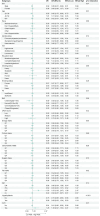The relationship between dietary flavonoid intake and hypertension: a cross-sectional study from NHANES
- PMID: 40520936
- PMCID: PMC12162475
- DOI: 10.3389/fcvm.2025.1518549
The relationship between dietary flavonoid intake and hypertension: a cross-sectional study from NHANES
Abstract
Objective: To evaluate the association between dietary flavonoid intake and hypertension using nationally representative data, considering increasing global hypertension prevalence and inconsistent evidence on flavonoids' protective effects.
Methods: This cross-sectional study analyzed 8,054 adults aged ≥20 years from NHANES 2007-2010 and 2017-2018. Flavonoid intake was assessed through two 24-hour dietary recalls and categorized into quartiles. Hypertension was defined by blood pressure ≥130/80 mmHg or self-reported diagnosis/medication use. Logistic regression models with progressive adjustment, restricted cubic spline regression for dose-response relationships, and subgroup analyses were conducted, accounting for complex sampling design.
Results: After full adjustment, participants in the highest quartile of total flavonoid intake showed 25% lower odds of hypertension compared to the lowest quartile (OR = 0.75, 95% CI: 0.60-0.93, p = 0.01). Among flavonoid subclasses, anthocyanidins (OR = 0.74, 95% CI: 0.58-0.93) and flavan-3-ols (OR = 0.76, 95% CI: 0.62-0.93) demonstrated the strongest protective associations. Significant effect modifications were observed for age (p for interaction = 0.01), hyperlipidemia (p for interaction <0.0001), and cardiovascular disease status (p for interaction =0.01), with stronger protective effects in younger adults and those without metabolic disorders.
Conclusion: Moderate dietary flavonoid intake, particularly anthocyanidins and flavan-3-ols, is inversely associated with hypertension risk. These associations vary significantly by age and metabolic status, suggesting potential for individualized dietary recommendations for hypertension prevention.
Keywords: NHANES; cross-sectional study; dietary intake; flavonoids; hypertension.
© 2025 Niu, Chen, Xiao, Li, Feng and Aierken.
Conflict of interest statement
The authors declare that the research was conducted in the absence of any commercial or financial relationships that could be construed as a potential conflict of interest.
Figures



Similar articles
-
Association between dietary flavonoid intake and depressive symptoms: A cross-sectional research.Gen Hosp Psychiatry. 2024 Jan-Feb;86:75-84. doi: 10.1016/j.genhosppsych.2023.12.005. Epub 2023 Dec 15. Gen Hosp Psychiatry. 2024. PMID: 38134552
-
Inverse association between dietary flavonoid intake and nocturia in middle-aged and older adults from NHANES 2007-2010.Sci Rep. 2025 Feb 5;15(1):4423. doi: 10.1038/s41598-025-88681-2. Sci Rep. 2025. PMID: 39910320 Free PMC article.
-
Association between dietary flavonoid intake and hypertension among U.S. adults.Front Immunol. 2024 Apr 3;15:1380493. doi: 10.3389/fimmu.2024.1380493. eCollection 2024. Front Immunol. 2024. PMID: 38680497 Free PMC article.
-
Association between Dietary Flavonoid Intake and the Likelihood of Frailty in Middle-Aged and Older Adults: A Population-Based Analysis from the National Health and Nutrition Examination Survey (NHANES).J Frailty Aging. 2024;13(4):359-368. doi: 10.14283/jfa.2024.40. J Frailty Aging. 2024. PMID: 39574255
-
Dietary flavonoid intake and risk of stomach and colorectal cancer.World J Gastroenterol. 2013 Feb 21;19(7):1011-9. doi: 10.3748/wjg.v19.i7.1011. World J Gastroenterol. 2013. PMID: 23467443 Free PMC article. Review.
References
-
- NCD Risk Factor Collaboration (NCD-RisC). Worldwide trends in hypertension prevalence and progress in treatment and control from 1990 to 2019: a pooled analysis of 1201 population-representative studies with 104 million participants. Lancet (London, England). (2021) 398(10304):957–80. 10.1016/S0140-6736(21)01330-1 - DOI - PMC - PubMed
LinkOut - more resources
Full Text Sources

